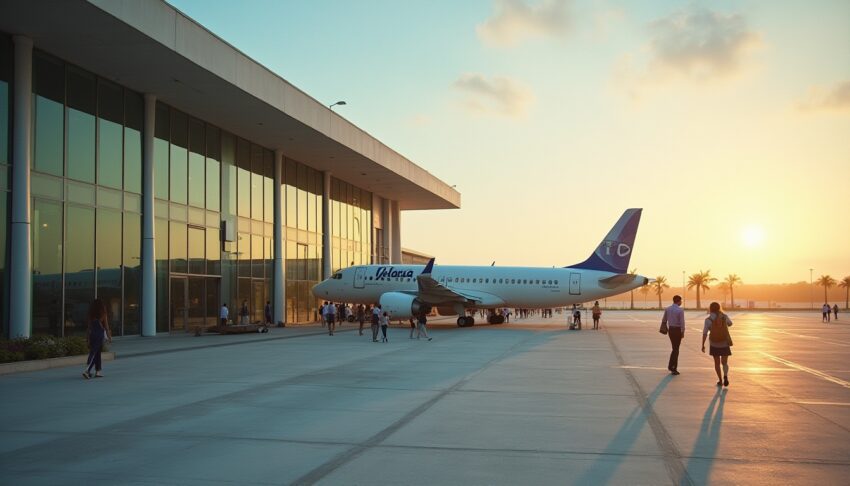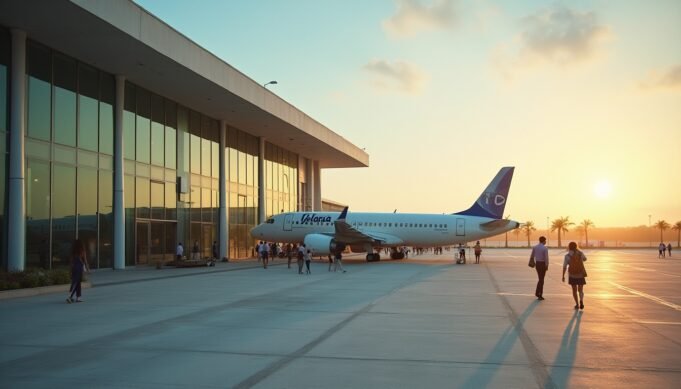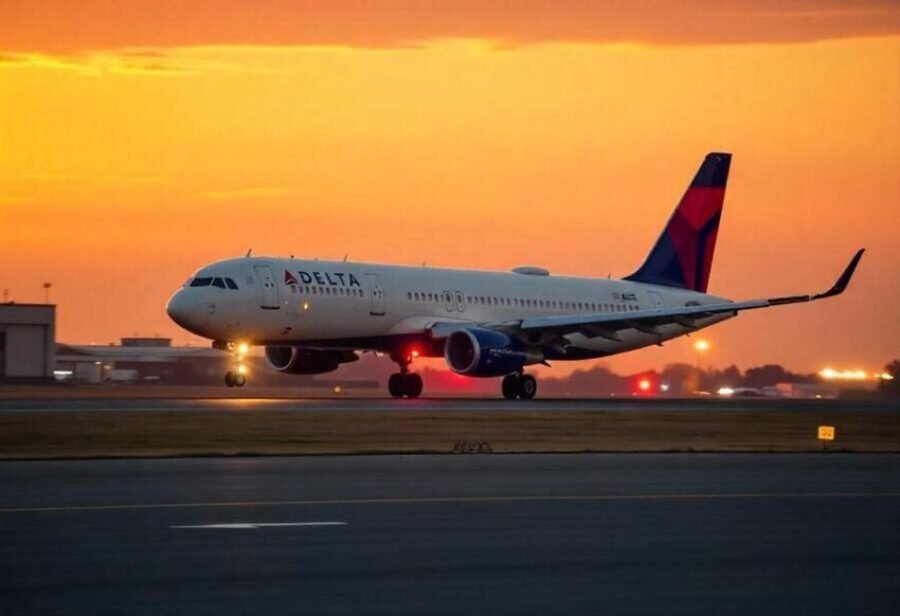Monday, July 7, 2025

Gone are the days when flying budget meant enduring cramped, dreary terminals that resembled prison waiting rooms more than aviation facilities. The Skytrax 2025 rankings of the world’s best low-cost airline terminals reveal a new breed of facilities that deliver premium experiences without the premium price tag.
These terminals have mastered the art of efficiency while maintaining passenger comfort, proving that traveling on a shoestring budget doesn’t require sacrificing dignity or decent coffee. Here’s a closer look at the top 10 low-cost airline terminals that are redefining what budget travel should be in 2025.
1. Paris Charles de Gaulle Terminal 3 (CDG T3) – France
Paris Charles de Gaulle Airport (CDG) is known for its elegance, but Terminal 3 (CDG T3) has won the crown as the world’s best low-cost airline terminal for 2025. This terminal serves as the primary hub for European low-cost carriers, offering passengers a taste of Parisian sophistication while maintaining budget-friendly operations.
CDG T3 boasts expanded security checkpoints, which significantly reduce wait times—typically keeping delays under 20 minutes, even during peak hours. The terminal’s design maximizes natural light through expansive windows, creating an airy, pleasant atmosphere that counters the cramped feeling often associated with budget terminals.
Dining options at CDG T3 are a blend of French culinary traditions and affordable pricing. You’ll find everything from classic croissants to contemporary bistro fare. The terminal’s retail spaces showcase both international brands and local French products, allowing travelers to experience Parisian culture without leaving the airport.
2. Tokyo Narita Terminal 3 (NRT T3) – Japan
Tokyo Narita’s Terminal 3 secures second place in the rankings by demonstrating Japanese efficiency in low-cost travel operations. Opened specifically for budget carriers, this terminal has revolutionized the low-cost experience through meticulous attention to detail and passenger convenience.
Automated check-in systems and digital boarding passes streamline the departure process, reducing staff requirements and operational costs while improving passenger flow. The terminal’s compact layout ensures maximum walking distance between any two points remains under 400 meters, making connections manageable, even with tight schedules.
NRT T3’s food court showcases authentic Japanese cuisine at budget-friendly prices, with ramen shops, sushi counters, and convenience stores stocked with local specialties. The terminal’s observation deck provides spectacular aircraft views, creating an entertainment option that costs nothing but time.
3. Kansai Terminal 2 (KIX T2) – Japan
Kansai International Airport’s Terminal 2 rounds out the top three, offering an innovative approach to low-cost operations. This purpose-built terminal serves budget airlines while maintaining the high service standards typical of Japanese aviation infrastructure.
Automated baggage systems and self-service kiosks minimize processing times while keeping costs low for both airlines and passengers. The terminal’s proximity to Terminal 1 allows easy connections for passengers requiring international transfers.
KIX T2’s dining options celebrate Kansai region cuisine, offering takoyaki stands, okonomiyaki restaurants, and local craft beer selections. The terminal’s retail spaces emphasize Japanese culture and technology, with everything from traditional crafts to cutting-edge electronics.
4. Centrair Nagoya Terminal 2 (NGO T2) – Japan
Centrair Nagoya International Airport’s Terminal 2 demonstrates that regional airports can compete with major hubs in low-cost operations. This facility serves budget carriers while maintaining the punctuality and service quality that defines Japanese aviation.
The terminal’s streamlined design eliminates unnecessary complexity, focusing on essential passenger services while maintaining comfort standards. Efficient security procedures and simplified check-in processes ensure smooth operations, even during peak travel periods.
Nagoya T2’s food court features regional specialties such as miso-based dishes and local seafood preparations. The terminal’s compact retail area offers essential travel items and local souvenirs at reasonable prices. Observation areas provide aircraft viewing opportunities while showcasing the surrounding landscape of central Japan.
5. Eindhoven Airport (EIN) – Netherlands
Eindhoven Airport (EIN) proves that smaller European facilities can deliver exceptional low-cost travel experiences. This Dutch airport serves as a major hub for budget carriers and is known for its compact size, which translates to shorter walking distances and quicker processing times.
With most passengers clearing security within 15 minutes, Eindhoven offers modernized facilities while preserving the user-friendly atmosphere. The single-terminal design simplifies navigation while maximizing operational efficiency.
Eindhoven’s dining options reflect Dutch culinary culture, with both local specialties and international favorites available at competitive prices. The airport’s retail spaces feature Dutch products and travel essentials, offering a shopping experience without overwhelming the traveler.
6. Kuala Lumpur International Airport Terminal 2 (KLIA2) – Malaysia
KLIA2 represents Southeast Asia’s commitment to excellent low-cost aviation infrastructure. This purpose-built terminal serves budget carriers while incorporating Malaysian hospitality and cultural elements that give the airport a distinct, welcoming feel.
The terminal’s spacious design accommodates high passenger volumes while maintaining comfortable conditions. Advanced air conditioning systems and natural lighting create pleasant environments despite Malaysia’s tropical climate. Efficient immigration and security procedures ensure minimal wait times while maintaining thorough processing.
KLIA2’s extensive food court showcases the diversity of Malaysian cuisine, offering everything from traditional Malay dishes to Chinese and Indian specialties. The terminal’s shopping areas offer a range of local products, international brands, and duty-free options.
7. Melbourne Terminal 4 (MEL T4) – Australia
Melbourne Terminal 4 (MEL T4) demonstrates Australian innovation in low-cost aviation operations. Serving both domestic and international budget carriers, this terminal maintains the relaxed, efficient atmosphere characteristic of Australian airports.
Advanced baggage handling systems and streamlined security procedures ensure smooth operations despite high passenger volumes. Proximity to Melbourne’s city center via express train connections adds convenience for budget travelers.
MEL T4’s dining options celebrate Australian culinary culture with local coffee roasters, craft breweries, and restaurants featuring regional produce. The terminal’s retail spaces offer Australian-made products and travel essentials at competitive prices.
8. Bangkok Don Mueang International Airport (DMK) – Thailand
Don Mueang International Airport (DMK) serves as Thailand’s primary low-cost aviation hub, blending historic charm with modern efficiency. Renovated terminals feature improved passenger flows and enhanced amenities, creating a pleasant environment for budget travelers.
The airport’s efficient immigration procedures and reasonable security wait times ensure smooth processing for millions of passengers each year. The airport’s proximity to Bangkok’s city center offers convenient access via multiple transportation options.
Don Mueang’s food courts showcase authentic Thai cuisine at budget-friendly prices, with options ranging from street food favorites to regional specialties. The shopping areas offer local products, handicrafts, and duty-free options.
9. Berlin Brandenburg Terminal 5 (BER T5) – Germany
Berlin Brandenburg’s Terminal 5 (formerly Berlin Schönefeld) represents German efficiency in low-cost operations. This terminal serves budget carriers while maintaining the punctuality and service standards expected from German aviation infrastructure.
The terminal’s practical design prioritizes functionality over aesthetics, ensuring efficient passenger flows and minimal operational complexity. Recent upgrades have enhanced amenities while maintaining cost-effective operations. The rail connections provide direct access to Berlin’s city center and surrounding regions.
BER T5’s dining options feature German cuisine alongside international favorites, with beer gardens and traditional restaurants available at reasonable prices. The terminal’s retail spaces offer German products and travel essentials.
10. London Luton Airport (LTN) – United Kingdom
London Luton Airport (LTN) completes the top 10, known for its efficient, no-frills operations that prioritize passenger convenience. Serving as a major hub for European budget carriers, Luton maintains reasonable service standards while offering competitive pricing.
Recent renovations have improved passenger amenities while preserving the airport’s straightforward, utilitarian approach. Express rail connections to central London make it easy for budget travelers to reach the city quickly and affordably.
Luton’s dining options feature British pub fare alongside international cuisine, all at reasonable pricing throughout the terminal. The airport’s retail spaces offer essential travel items and UK-made products.
Bottom Line
These 10 terminals prove that budget travel doesn’t require sacrificing comfort or convenience. From Paris’s sophisticated approach to Tokyo’s efficient minimalism, each facility demonstrates that the best low-cost terminals understand their passengers’ needs: quick processing, reasonable prices, and just enough amenities to make the journey pleasant.
They’ve mastered the delicate balance between cutting costs and cutting corners, ensuring that your wallet stays happy while your travel experience remains surprisingly satisfying.
Stay tuned with us. Further, follow us on social media for the latest updates.
«Enjoyed this post? Never miss out on future posts by following us»
Tags: Airline News, Australia Tourism news, bangkok, berlin, Eindhoven, France Tourism News, Germany Tourism News, japan, Japan Tourism news, kansai, Kuala Lumpur, London Luton, low-cost, Low-Cost airlines news, Malaysia tourism news, Melbourne, Netherlands, Paris, Thailand, Tokyo, Travel News, United Kingdom Tourism news











